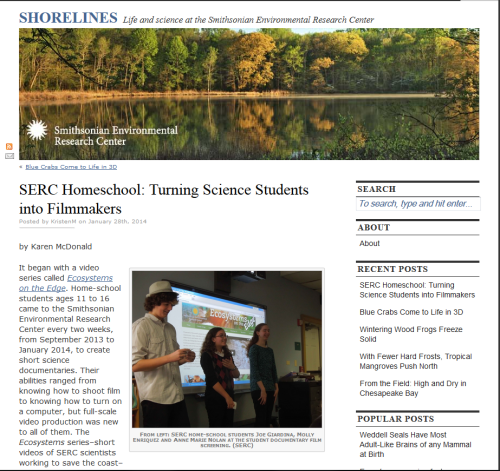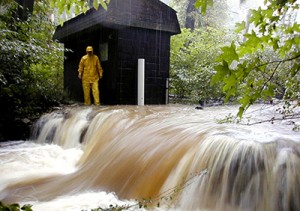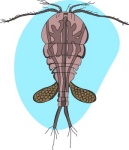Home School Sneak Peek 13-16 yr. old Classes Spring 2014 & Invitation to Student Documentary Class Film Showing

Ecosystems on the Edge Inspired Student Documentary Film Class
Final Student Project Showing & Invitation
Thursday, January 16th
2-3 pm
Reed Center Classroom (FREE)
Students from the documentary class will show their final projects (8-10 minutes) and discuss the challenges and successes during their film making process. These video are inspired by the Ecosystems on the Edge documentary series, newly released, about SERC research. Please come to support the students!
Introduction to a Science Laboratory
Home School ages 13-16 yr.
Instructor: Karen McDonald, Education Outreach Coordinator
Registration will begin on February 7th at 9 am.
McDonaldK@si.edu
Course Information
This course is designed as an introduction to core laboratory techniques, familiarity with laboratory equipment such as scales, compound microscopes, slide making, flasks, graduate cylinders, and pipettes. We will also cover lab etiquette, safety, and experimental design. Students will create a project based on fresh water ecosystems and they will analyze water samples, plankton communities, micro, and macro invertebrates, and landscape topography (using Google Earth) for a comparative study of habitats. Data will be taken in the field and samples brought back to the lab for analysis.
Course times: Every other Thursday, 1:30-3:30 pm every other week (March 6th-May 21st)
NOTE: Students are required to register for the entire block of courses below. Due to the nature of this course class material builds upon each subject. If students miss a class it will be incumbent upon them to make up materials with their instructor. Due to the nature of lab work students may be asked to come in between classes to analyze samples before they deteriorate or expire.
Registration: The cost for 7 classes and lab materials is $165.
Texts and Supplies: Students will be provided with a list of supplies to bring to class, such as a field backpack, markers, baggies, etc upon registration. However, they must have a “Student Lab Notebook” with permanent binding, from Hayden McNeil: (100 or 50 page count). This can be found on Amazon for ($16-$18) http://www.amazon.com/Student-Lab-Notebook-Carbonless-Duplicate/dp/1930882505/ref=sr_1_2?ie=UTF8&qid=1389275392&sr=8-2&keywords=student+lab+notebook+with+permanent+binding
Course Outline
March 6th- Introduction to a Laboratory Setting
In this class students will be introduced to the proper safety in a lab, laboratory equipment (scales, flasks, graduated cylinders, pipettes, etc.), and lab etiquette. We will be working in the new building/lab space (if construction permits) on the main campus.
March 20th– How to Write Lab Reports and Choosing Projects
Students will be introduced to how to write lab reports and record data. They will also consider possible projects and decide on a hypothesis to test.
April 3rd– Preparing Slides, Microscopes, and Setting up the Lab
Students will be introduced to using compound microscopes, their settings, maintenance, and care. We’ll also practice preparing glass slides with cover slips and making observations. Part of the class will be dedicated to setting up the lab in preparation for data collection and analysis.
April 17th– Field Study, Data Collection, and Lab Work (Aquatic Ecosystems)
We will journey into the field to collect samples of water, soil, micro and macro invertebrates (possibly plants) from local fresh water bodies of water. Afterwards we’ll return to the lab for processing.
May 1st– Laboratory Analysis and Field Study Continued
Students will continue sample collection processing, writing reports, and preparing for their final paper and presentation.
May 8th– How to Present a Scientific Paper
In this class we’ll discuss how to properly write and present a scientific paper, the guidelines for presenting, and best practices. We will try to hone student’s confidence and public speaking skills. [Students turn in lab report]
May 22nd – Final Project Paper Presentation
The final presentation of research papers will be open to parents and families. Students will present their findings and turn in a final research paper.
Ecosystems on the Edge Inspired Student Documentary Film Final Student Project Showing & Invitation
Thursday, January 16th
2-3 pm
Reed Center Classroom (FREE)
Students from the documentary class will show their final projects and discuss their challenges and successes during the film making process. These video are inspired by the Ecosystems on the Edge documentary series, newly released, about SERC research. Please come to support the students!
Read Full Post »



